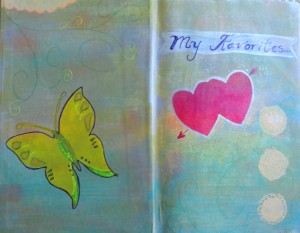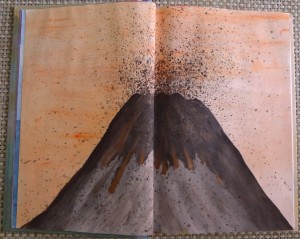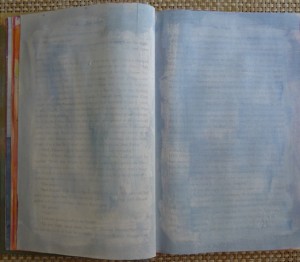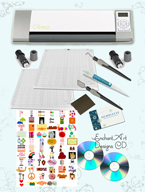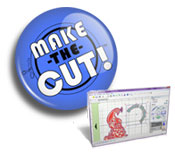This is the second part of my series about altering books. If you need to read the first part, you can find it here.
Once you have all the pages glued and dried, it’s time to start building them. The first thing you need is the appropriate background upon which everything else will be glued, written or painted.
There are different options for backgrounds. One is to cover the pages with paint partially or completely; or if you prefer, you can cover the pages with papers in a collage form.
In this step, you are going to start adding your own personality to the book. But first you need to have an idea of the content of the pages.
For example, I will be creating pages that represent my favorite things, so I made a list of my favorites and now I know more or less the colors of my pages. You can always add more color later also.
There are different ways to add color to the book:
Decide if you want all the wording of the page to be covered or not. Wherever you want to hide the words, apply a thin layer of gesso with a brush. I applied gesso to all my pages in this project, since I didn’t want any of the writing to appear. Also, apply gesso if your pages are too thin or delicate. The gesso will make your pages ready for any kind of paint.
1. Painting with Acrylics:
Paint directly to the pages using acrylic paints. Remember that paints can vary, and some colors are more transparent than others.
To create a translucent layer of paint, mix your paint with glazing medium; use more medium if you want the paint more translucent. You can also use water to dilute the paint. Use this mixture directly with a brush; before it dries, you can also rub off some paint using a paper towel. Add more layers if you’d like using the same color in a deeper shade or using different colors.
When you paint a page, protect the other pages by adding a piece of scrap paper before and after the pages you are going to paint (I recycle the junk mail like this).
2. Painting with Inkpads:
Inkpads come in different colors and can be used by rubbing the pages directly or by using a sponge to apply the ink on the page. I like to use inkpads on the edges of the page, just to give it more depth.
3. Use any other medium of your preference to paint your pages. Also, use different sizes of brushes, stencils, even your fingers can aide you to achieve certain effects. I challenge myself to use household things with texture to apply paint. You can use bubble wrapping by just applying paint with a brush on the wrapping material and then pressing it on the paper.
4. Look around your house and think what else you can use. What if you peel one layer of a corrugated cardboard, apply paint to the raised surface, press it to your page and use those lines for journaling?
Use your imagination; this is your book, don’t be afraid of mistakes. If you don’t like something, get some glue and paper to cover the page or apply gesso and start again.
5. Think about other ways that you can add texture to your page. Maybe you want to add some masking tape or some cutouts, squares, circles, etc. They will be covered totally or partially according to what you have in mind.
6. If you don’t want to paint the page, then you can glue papers to cover it. Cut different sizes of paper, with scissors or by hand, and start gluing them by overlapping the pieces of paper. Then, apply a wash (very runny paint) of white or any other color and paint over everything to unify the page.
Here are some examples of my painted backgrounds, so you have an idea. These pages are not completed, I just started. I don’t know if I can declare them completed one day, we’ll see.
I used acylics, Sharpie markers for outlines, metallic markers.

White paint, some alphabet stamps, traced my hand.
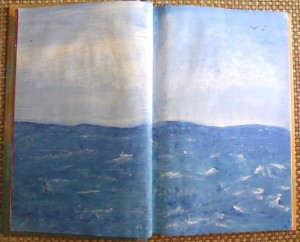
Blue and white acrylic paint to make the ocean and the sky. I mix both colors at the same time without letting them dry.
I used brown, white paint. Also, I used bronze metallic paint.
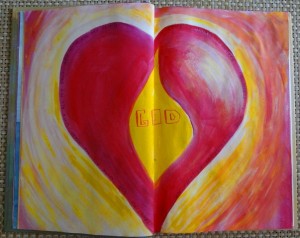
Different shades of yellow and red with white.
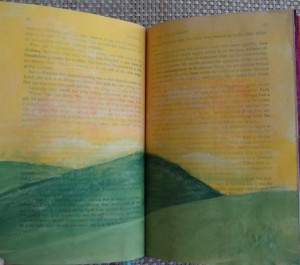
I left some text showing here.

I used my knife to make marks in the wet paint.
Many times, I don’t wash my brush before I use the rest of the paint that is left in other pages. I start building color and background and at the same time; I hardly waste any paint. Here are some examples:
I hope this is inspiring to you and please let me know if you have any question or comment.
Glenda
Tags: ALTERED BOOK 101 SERIES, altered book tutorial, how to paint book pages
